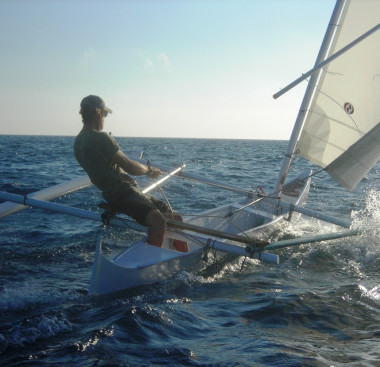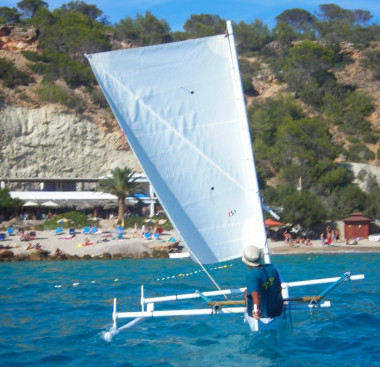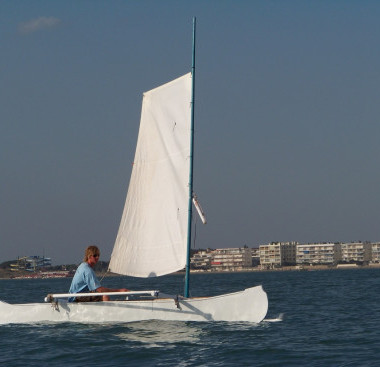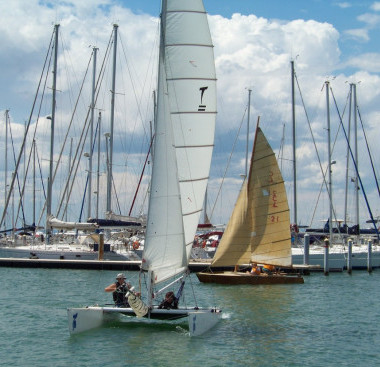Sans dérive, sans safran
A report from Frédéric Monsonnec on the Golden Oldies Multihulls meet up in Port Camargue, France, May 29-June1, 2014. ~Editor
No centerboard, no rudder!
Every year, the Golden Oldies Multihulls association organizes events in the Mediterranean (See Golden Oldies Trophy 2103 for report on the Sète meeting in 2013) and on the Atlantic coast. During these meetings, passionate fans of old racing multihulls (25 years minimum), gather to sail - and to “rewrite the history” of these old veterans. This year, for the pleasure of the members and the spectators, the show was not only on the sea with Pat’s, VSD, Tahiti Douche, Aile Bleue, etc., but also in the Mediterranean town of Port Camargue with the smaller “Golden Oldies”.
In Port Camargue the small boats were represented by:
- Pelican, a Tornado built in 1975 with a plywood deck. Property of Emmanuel Pironneau
- Catalina, a catamaran designed in 1962 by André Allegre (Pen Duick IV, Cap 33…) and who had not sailed since probably 40 years before this event!
- A Jukung from Bali, an canoe outrigger trimaran designed by Christian Campi and skippered by Don Carslaw and his son Sean
- A Hawaiian canoe also designed by C. Campi
- Lakana, a proa from Madagascar, built by Stuart Rogerson, the owner and rescuer of VSD. Stuart came from Ibiza with Lakana on the deck of VSD
- A Patin a Vela, an extraordinary class of Spanish catamarans, fruit of the work of Luis and Emilio Monge in 1925/26
Two of these boats have no rudder: the Patin and Lakana. The Hawaiian canoe uses an oar and the Balinese outrigger has a deported rudder. Lakana is steered only by changing the position of the center of gravity and therefore the center of drift. For the Patin, the mainsheet and the rake of the mast is also adjusted.
Patin a vela
The Patin a vela is a boat for one man or woman but the volume is sufficient for a second person. It is the oldest sport catamaran class in the world! To tack, the “helmsman”, moves forward on the windward hull, leans his body on the mast and against the sail. The nose of the boat sinks and the boat turns into the wind. This class is especially popular in Spain, but Patins also race in Belgium, Argentina, France. The Patin was born on the coast of Barcelona during the last part of the nineteenth century. Initially it had less beam than today, and was powered with a long oar. In 1871 a race took place in this configuration in the port of Barcelona. So it was an ancestor of the SUP. Created by carpenters without a nautical knowledge, they devised a boat capable of launching through the surf. A boat with two hulls for stability and fine bows to get through the waves but without a rudder or board for departures and beach arrivals. In 1926, members of the swimming club of Barcelona team put a sail on the structure to facilitate their return to the beach. The first large sailing regatta was in 1932.
- Length: 18.4 ft - 5.60 m
- Width: 1.60 m
- Weight: 216 lbs - 98 kg
- Sail area: 135.6 sq ft – 12.60 m²
VIDEO
Building of a Patin a vela
Lakana
Lakana is an outrigger canoe inspired by the native craft of Madagascar. She’s a two-seater built in plywood and epoxy. It can be rigged with either one or two outrigger floats. The history of Madagascar begins between 200 BC and 500 AD when seafarers on outrigger canoes arrived from south East Asia, from Borneo or the South of Celebes and probably associated with settlers from the African coast. Christian Campi drew LAKANA inspired by the Vezo outriggers. The Vezos are a people who in the past occupied the entire west coast of the big Island. They are one of the last nomadic tribes of Madagascar. When they spend time away from their village, they make a temporary camp, using the square sail as a tent. Their canoes are steered with a paddle, but on this kind of boat the weight of the crew can have a strong effect on the underwater profile, and thus the position of lateral resistance. The placement of weight and sail trim, combined with the steering device, all contribute to the steering by the crew. Christian simplified the rectangular shape of the sail by using a sprit and to be able to steer Lakana single-handed. When Stuart Rogerson built the first model, he discovered she could be steered without a paddle at all! It was obvious for Stuart because in the past there had a school of Patin a vela in Ibiza. Christian went to Ibiza to discover this unsuspected feature. He was pleasantly surprised, and it was a pure coincidence that Lakana was so well balanced.
- Length: 16 ft – 4.90 m
- Weight: 100 lbs - 45 kg
- Sail area: 59.2 sq ft – 5.5 m²
Sailing With With No Rudder
After a sail on the Tornado, and the loss of one rudder, I tried the Hawaiian outrigger… and we broke a small part of the rigging! Difficult with such a record to obtain a new command! But I did not take into account the kindness of the “clan” Rogerson. Marina said to me: “You can take Lakana out if you want. Steering is very simple: to gybe, you move back and to tack that’s the inverse… You will find a bucket inside if you capsize…” After a long tack of approximately 30m, I capsized! That seems to be normal for the first sail. When Stuart sailed Lakota for the first time, he capsized after 3 meters with his mobile phone and his passport in the pocket! After a little bath in the harbor, and after using my friend the bucket, Lakana was no longer a submarine but a boat again. Now, if I do not want to lose my dignity, I have to use my brain and control my body! I’m glad that my friends are at sea (no members of GOM in the spectator fleet) and the wind is not too strong. After 10 minutes, it was like riding a bicycle, a great pleasure, better than with a rudder! The control mode is instinctive. If I didn’t already have two little hydrofoil prototypes (who haven’t seen the color of the water for several years), I would order some plans from Christian Campi! I did not find the time to sail with the “King of the Patin”, Tony Blanco Casana, that will remain for a next gathering.
If you get the chance to test sail this type of boat, make no hesitation, it is like a new discipline!
~ Fred Monsonnec for Proa File 08/2014
VIDEO
Lakana and Patin a vela Golden Oldies Trophy 2014









What does the underwater shape of the Lakana look like? Is it deep V like the Patin? Now about in profile? Very cool!